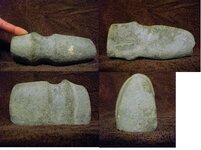vegalyrae
Jr. Member
i normally hunt fossils on grades and rock slides and have very little experience in fields....mainly just walking through them and hoping for the best. Friday I will be going out on a hunt to the scioto river bottoms near the fuert hill site, VERY excited might I add.  it is a large plot of farmland that floods every winter with the scioto river and ohio river spilling into the lowlands.
it is a large plot of farmland that floods every winter with the scioto river and ohio river spilling into the lowlands.
however...I havent been very successful in finding points thus far, in fact, i have yet to find one, EVER, even broken. Now i have found an axe but to be honest that thing was HUGE and impossible to miss. lol
my question is this...what advice you would give to a beginner who is looking for MUCH smaller artifacts? it has been raining for days (remnants of sandy) here and this particular area was plowed about 3 weeks ago before the rain hit. (not sure if that helps any) I knew it's going to be very very muddy. what kind of tools should i bring with me, what should i be keeping my eyes out for? ect
any help would be greatly appreciated!!
 it is a large plot of farmland that floods every winter with the scioto river and ohio river spilling into the lowlands.
it is a large plot of farmland that floods every winter with the scioto river and ohio river spilling into the lowlands.however...I havent been very successful in finding points thus far, in fact, i have yet to find one, EVER, even broken. Now i have found an axe but to be honest that thing was HUGE and impossible to miss. lol
my question is this...what advice you would give to a beginner who is looking for MUCH smaller artifacts? it has been raining for days (remnants of sandy) here and this particular area was plowed about 3 weeks ago before the rain hit. (not sure if that helps any) I knew it's going to be very very muddy. what kind of tools should i bring with me, what should i be keeping my eyes out for? ect
any help would be greatly appreciated!!

Amazon Forum Fav 👍
Upvote
0




